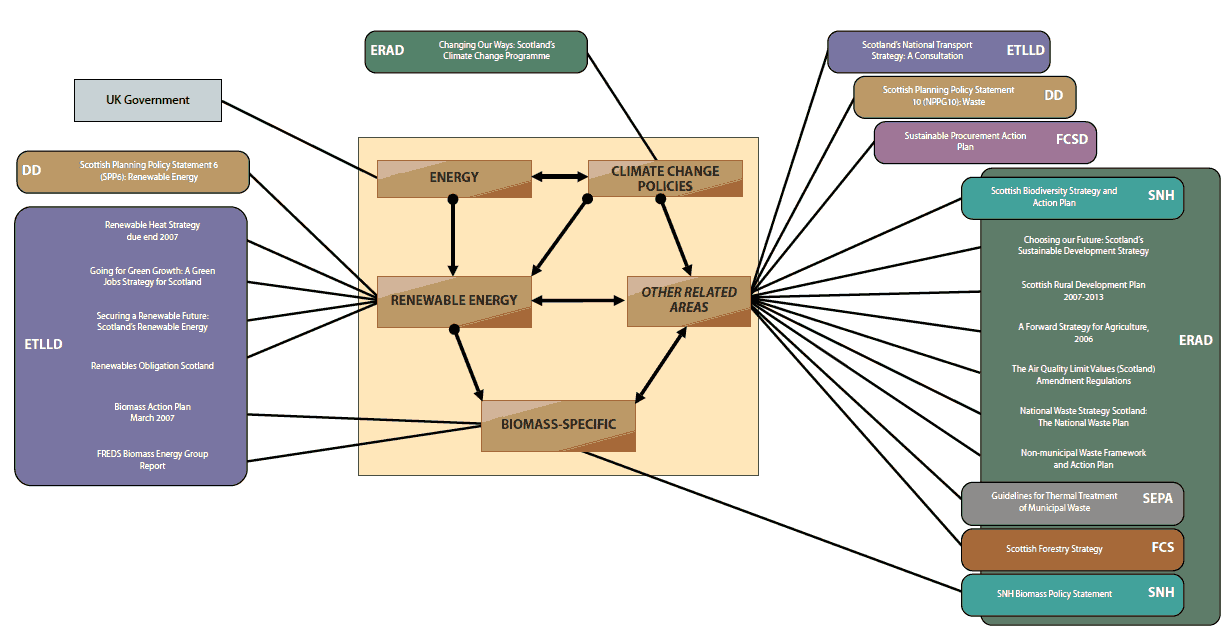Biomass action plan for Scotland
Biomass action plan for Scotland.
3. WIDER CONTEXT
EUROPE
3.1 Energy is crucial in helping Europe achieve its objectives for growth, jobs and sustainability. High oil and gas prices put the spotlight on Europe's increasing dependency on imported energy. The union is responding to this challenge by putting in place a range of measures to help Europe to reduce dependence on energy imports, increase sustainability and stimulate growth and jobs. The key drivers in the EU Biomass Action Plan can be summarised as:
- the desire for stronger yet sustainable economic growth;
- the need to reduce energy demand;
- the commitment to increase use of renewable energy sources;
- the desire to diversify energy sources, particularly focussing on domestic and sustainable resources;
- the opportunity to enhance international co-operation.
3.2 Biomass is one component of the measures needed to achieve these objectives. It is within this wider context of an integrated and coherent energy policy and, in particular, of the promotion of renewable energy sources that the Commission presented its Action Plan. In short, it is a first step towards improving coordination of the bioenergy sector.
SCOTLAND
3.3 Scotland has the potential to be the renewables powerhouse of Europe. We have a unique combination of natural assets, with nearly 60GW of raw electricity generating potential to draw upon, including off-shore and on-shore wind, wave and tidal and biomass. In supporting a diverse mixture of clean energy, our focus is on those renewable technologies yet to establish a significant foothold in Scotland, including biomass, marine and hydrogen.
3.4 The Executive has set ambitious targets to generate 18% of Scotland's electricity from renewable sources (as a proportion of demand) by 2010, rising to 40% by 2020, which we are already well on the way to achieving. The Executive announced in February 2007 it has met the 2010 target early. There are no targets set for the biomass component, however several large-scale projects including the E-ON project at Lockerbie will make a difference and the Executive will monitor the contribution of biomass to ensure it is not missing out.
3.5 There is no available data on current renewable heat use in Scotland, although there is around 177 MWth installed capacity in large-scale projects and around 8 MWth in small-medium scale projects. Targets for heat will be considered as part of the forthcoming Renewable Heat Strategy. Over the next year, the Executive will focus on expanding this market through the development of a Renewable Heat Strategy and the implementation of the Scottish Biomass Support Scheme.
3.6 In terms of biomass use, Changing Our Ways: Scotland's Climate Change Programme (Scottish Executive, 2006) estimates that 750,000 green tonnes of wood will be used by 2010, rising to 1,000,000 green tonnes by 2020. Overall, the report estimates that bioenergy measures will contribute to removals of an additional 0.12 MtC per year by 2010, rising to 0.18 MtC per year by 2015 and 0.23 MtC per year by 2020. With projects in development, these target will be clearly exceeded and there will be increasing competition for timber volume. Expansion of the resource is a key aim for the Scottish Forestry Strategy and a Forward Strategy for Agriculture.
3.7 A number of recommendations were made by the Biomass Energy Group ( BEG) of the Forum for Renewable Energy Development in Scotland ( FREDS), set up in 2002 to bring together government, industry and academia to advise how best to break down the barriers to renewables developments. The group made a series of recommendations, many of which have already been implemented and are discussed throughout the Plan.
Policy co-ordination
3.8 Bioenergy is a cross-cutting topic, bringing together a range of policy areas, including agriculture, forestry, energy, transport, rural development, and climate change. Each area recognises the importance and benefits of developing the biomass sector as part of their overall policy and this is reflected in existing policy documents, including: Securing a Renewable Future: Scotland's Renewable Energy (2003); Going for green growth: a green jobs strategy for Scotland (2005); The Scottish Forestry Strategy (2006), Changing Our Ways: Scotland's Climate Change Programme (2006) and A Forward Strategy for Scottish Agriculture: Next Steps (2006).
3.9 The Renewables and Consents Policy Unit, part of the Enterprise, Transport and Lifelong Learning Department ( ETLLD), has the lead role in coordination of biomass policy across the Executive and beyond. However, depending on the subject matter other areas of the Executive can assume a leading role. It is not usual therefore to have a number of policy areas involved in initial discussions on emerging policies and how they might impact on existing or developing policies elsewhere.
3.10 In practice, coordination of policies relating to biomass works effectively. An Interdepartmental Bioenergy Group was established to ensure that all relevant Executive policy areas were apprised of biomass developments and to ensure that engagement takes place at an early stage. This group will continue to meet on a regular basis and part of its remit will be to monitor the progress of the Action Plan, as well as ensuring biomass policy is developed in a joined up way across the Executive and its agencies. This will include the need to ensure that the regulatory environment in which the biomass industry operates is developed in a sustainable way. The Group will produce an Annual Report outlining its activity including progress with delivering the Action Plan.
3.11 The diagram on the page opposite illustrates the wider context in which bioenergy policy is supported across the Executive.
POLICY MAP

There is a problem
Thanks for your feedback